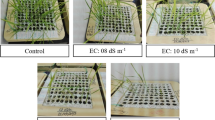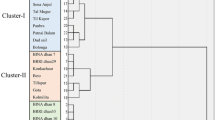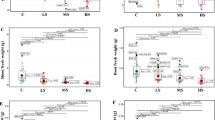Abstract
The present investigation was carried out to evaluate 33 rice landrace genotypes for assessment of their salt tolerance at seedling stage. Growth parameters like root length, shoot length and plant biomass were measured after 12 days of exposure to six different levels of saline solution (with electrical conductivity of 4, 6, 8, 10, 12 or 14 dS m −1). Genotypes showing significant interaction and differential response towards salinity were assessed at molecular level using 11 simple sequence repeats (SSR) markers, linked with salt tolerance quantitative trait loci. Shoot length, root length and plant biomass at seedling stage decreased with increasing salinity. However, relative salt tolerance in terms of these three parameters varied among genotypes. Out of the 11 SSR markers RM8094, RM336 and RM8046, the most competent descriptors to screen the salt tolerant genotypes with higher polymorphic information content coupled with higher marker index value, significantly distinguished the salt tolerant genotypes. Combining morphological and molecular assessment, four lanraces viz. Gheus, Ghunsi, Kuthiahara and Sholerpona were considered as true salt tolerant genotypes which may contribute in greater way in the development of salt tolerant genotypes in rice.





Similar content being viewed by others
Abbreviations
- EC:
-
Electric conductivity
- QTL:
-
Quantitative trait loci
- SSR:
-
Simple sequence repeats
- UPGMA:
-
Unweighted pair group method arithmetic average
References
Akbar M, Khush GS, HilleRisLambers D (1986) Genetics of salt tolerance in rice. Proceedings of the Rice Genetics. International Rice Research Institute, Manila, Philippines, pp 399–409
Aliyu R, Adamu AK, Muazu S, Alonge SO, Gregorio GB (2011) Tagging and Validation of SSR markers to Salinity Tolerance QTLs in Rice (Oryza spp), vol 1. 2010 International Conference on Biology, Environment and Chemistry, IPCBEE, IACSIT press, Singapore, pp 328–332
ANU (2006) Technological Transformation of Productivity, Profitability and Sustainability: Rice. In The First Ten K R Narayanan Orations: Essays by Eminent Persons on the Rapidly Transforming Indian Economy. Australia South Asia Research Centre The Australian National University. http://epress.anu.edu.au/narayanan/mobile_devices/pr01.html
Beyene Y, Botha AM, Myburg AA (2005) A comparative study of molecular and morphological methods of describing genetic relationships in traditional Ethiopian highland maize. Afr J Biotechnol 4:586–595
Bhuiyan MAR (2005) Efficiency in evaluating salt tolerance in rice using phenotypic and marker assisted selection. M.Sc. dissertation. Department of Genetics and Plant Breeding, Bangladesh Agricultural University, Bangladesh, p 96
Ding C (2004) K-means clustering via principal component analysis. ICML’04 Proceedings of the twenty-first International Conference on Machine Learning, Banff, Canada
Doyle JJ, Doyle JL (1990) A rapid total DNA preparation procedure for fresh plant tissue. Focus 12:13–15
El-Hendawy SE, Hu Y, Yakout GM, Awad AM, Hafiz SE, Schmidhalter U (2005) Evaluating salt tolerance of wheat genotypes using multiple parameters. Eur J Agron 22:243–253
Ferdose J, Kawasaki M, Taniguchi M, Miyake H (2009) Differential sensitivity of rice cultivars to salinity and its relation to ion accumulation and root tip structure. Plant Prod Sci 12:453–461
Flowers TJ, Yeo AR (1995) Breeding for salinity resistance in crop plants: where next? Aust J Plant Physiol 22:875–884
Garland SH, Lewin L, Abedinia M, Henry R, Blakeney A (1999) The use of microsatellite polymorphism for the identification of Australian breeding lines of rice (Oryza sativa L). Euphytica 108:53–63
Gopalan C, Rama Sastri BV, Balasubramanian S (2007) Nutritive Value of Indian Foods. National Institute of Nutrition (NIN), ICMR, India
Gregorio GB (1997) Tagging salinity tolerance genes in rice using amplified fragment length polymorphism (AFLP). PhD. thesis, University of the Philippines, Los Baños. pp. 118.
Gregorio GB, Senadhira D, Mendoza RD (1997) Screening rice for salinity tolerance, vol 22, IRRI Discussion paper Series. International Rice Research Institute, Laguna Philippines, pp 1–30
Han-yong Y, Xing-hua W, Yi-ping W, Xiao-ping Y, Sheng-xiang T (2004) Study on genetic variation of rice varieties derived from Aizizhan by using morphological traits, allozymes and simple sequence repeat (SSR) markers. Chin J Rice Sci 18:477–482
Islam MM (2004) Mapping salinity tolerance genes in rice (Oryza sativa L.) at reproductive stage. Ph.D. Dissertation. University of the Philippines Los Baños College, Laguna, Philippines, pp 1–149
Jones MP (1986) Genetic analysis of salt tolerance in mangrove swamp rice. Proceedings of the Rice Genetics. International Rice Research Institute, Manila, Philippines, pp 411–422
Karhu A, Hurme P, Karjalainen M, Karvonen P, Kärkkäinen K, Neale D, Savolainen O (1996) Do molecular markers reflect patterns of differentiation in adaptive traits of conifers? Theor Appl Genet 93:215–221
Karp A, Seberg O, Buiatti M (1996) Molecular techniques in the assessment of botanical diversity. Ann Bot 78:143
Leland EF, Catherine MG, Eugene VM, Scott ML (1994) Time of salt stress affects growth and yield components of irrigated wheat. Agron J 86:100–107
Lutts S, Kinet JM, Bouharmont J (1995) Changes in plant response to NaCl during development of rice (Oryza sativa L.) varieties differing in salinity resistance. J Exp Bot 46:1843–1852
Ma HL, Zhu JG, Liu G, Xie ZB, Wang Y, Yang L, Zeng Q (2007) Availability of soil nitrogen and phosphorus in a typical rice–wheat rotation system under elevated atmospheric [CO2]. Field Crop Res 100:44–51
Mass EV (1986) Salt tolerance of plants. Appl Agri Res 1:12–26
Mass EV, Grieve CM (1994) Tiller development in salt-stressed wheat. Crop Sci 34:1594–1603
Messmer MM, Melchinger AE, Herrmann RG, Boppenmaier J (1993) Relationships among early European maize inbreds: comparison of pedigree and RFLP data. Crop Sci 33:944–950
Mitin A (2009) Documentation of selected adapted strategies to climate change in rice cultivation. East Asia Rice Working Group, pp. 25–28
Mohammadi-Nejad G, Arzani A, Rezai AM, Singh RK, Gregorio GB (2008) Assessment of rice genotypes for salt tolerance using microsatellite markers associated with the saltol QTL. Afr J Biotechnol 7:730–736
Munns R, James RA, Läuchli A (2006) Approaches to increasing the salt tolerance of wheat and other cereals. J Exp Bot 57:1025–1043
Peng S, Cassman KG, Virmani SS, Sheehy J, Khush GS (1999) Yield potential trends of tropical rice since the release of IR8 and the challenge of increasing rice yield potential. Crop Sci 39:1552–1559
Powell W, Morgante M, Andre C, Hanafey M, Vogel J, Tingey S, Rafalski A (1996) The utility of RFLP, RAPD, AFLP and SSR (microsatellite) markers for germplasm analysis. Mol Breed 2:225–238
Quijano-Guerta C, Kirk GJD (2002) Tolerance of rice Germplasm to salinity and other chemical stresses in tidal wetlands. Field Crop Res 76:111–121
Rohlf FJ (1993) NTSYS-PC Numerical taxonomy and multivariate analysis system. Version 2.0. Exeter Software, Applied Biostatistics Inc. Setauket, New York.
Roldán-Ruiz I, Van Euwijk FA, Gilliland TJ, Dubreuil P, Dillmann C, Lallemand J, De Loose M, Baril CP (2001) A comparative study of molecular and morphological methods of describing relationships between perennial ryegrass (Lolium perenne L.) varieties. Theor Appl Genet 103:1138–1150
Smith JSC, Chin ECL, Shu H, Smith OS, Wall SJ, Senior ML, Mitchell SE, Kresovich S, Zeigle J (1997) An evaluation of the utility of SSR loci as molecular markers in maize (Zea mays L.): comparisons with data from RFLPs and pedigree. Theor Appl Genet 95:163–173
Suh HS, Sato YI, Morishima H (1997) Genetic characterization of weedy rice (Oryza sativa L.) based on morpho–physiology, isozymes and RAPD markers. Theor Appl Genet 94:316–321
Taran B, Zhang C, Warkentin T, Tullu A, Vandenberg A (2005) Genetic diversity among varieties and wild species accessions of pea (Pisum sativum L.) based on molecular markers and morphological and physiological characters. Genome 48:257–272
Thanh ND, Zheng HG, Dong NV, Trinh LN, Ali ML, Nguyen HT (1999) Genetic variation in root morphology and microsatellite DNA loci in upland rice (Oryza sativa L.) from Vietnam. Euphytica 105:53–62
Weiguo Z, Zhihua Z, Xuexia M, Yong Z, Sibao W, Jianhua H, Hui X, Yile P, Yongping H (2007) A comparison of genetic variation among wild and cultivated Morus Species (Moraceae: Morus) as revealed by ISSR and SSR markers. Biodivers Conserv 16:275–290
Yang GP, Maroof MAS, Xu CG, Zhang Q, Biyashcv RM (1994) Comparative analysis of microsatellite DNA polymorphism in land races and cultivars of rice. Mol Gen Genet 245:187–194
Yeo AR, Flowers TJ (1986) Salinity resistance in rice (Oryza sativa L.) and a pyramiding approach to breeding varieties for saline soils. Effect of drought on plant growth. In: Turner NC, Passioura JB (eds) Salts in soils. CSIRO, Melbourne, Australia, pp 161–173
Yokoi S, Bressan RA, Hassegawa PM (2002) Salt Stress tolerance of Plant. JIRCUS Working Report pp. 25–33
Zeng L, Shannon MC, Grieve CM (2002) Evaluation of salt tolerance in rice genotypes by multiple agronomic parameters. Euphytica 127:235–245
Acknowledgments
The authors are grateful to Central Research Institute for Jute and Allied Fibres (CRIJAF), Barrack pore, North 24-Parganas, West Bengal, India for supporting the molecular marker experiment and Faculty Centre for Integrated Rural Development and Management, School of Agriculture and Rural Development, Ramakrishna Mission Vivekananda University, India for providing the key research facilities.
Author information
Authors and Affiliations
Corresponding author
Rights and permissions
About this article
Cite this article
Ali, M.N., Yeasmin, L., Gantait, S. et al. Screening of rice landraces for salinity tolerance at seedling stage through morphological and molecular markers. Physiol Mol Biol Plants 20, 411–423 (2014). https://doi.org/10.1007/s12298-014-0250-6
Received:
Revised:
Accepted:
Published:
Issue Date:
DOI: https://doi.org/10.1007/s12298-014-0250-6




